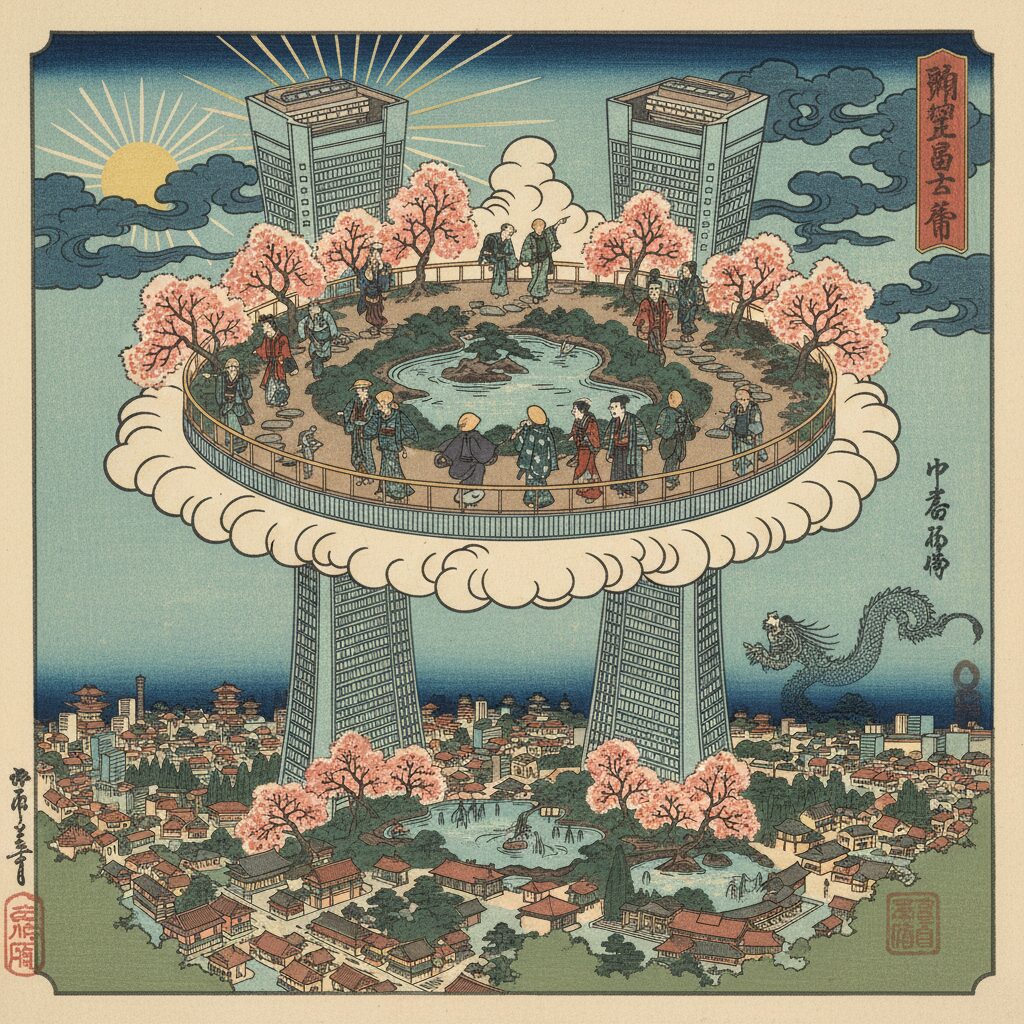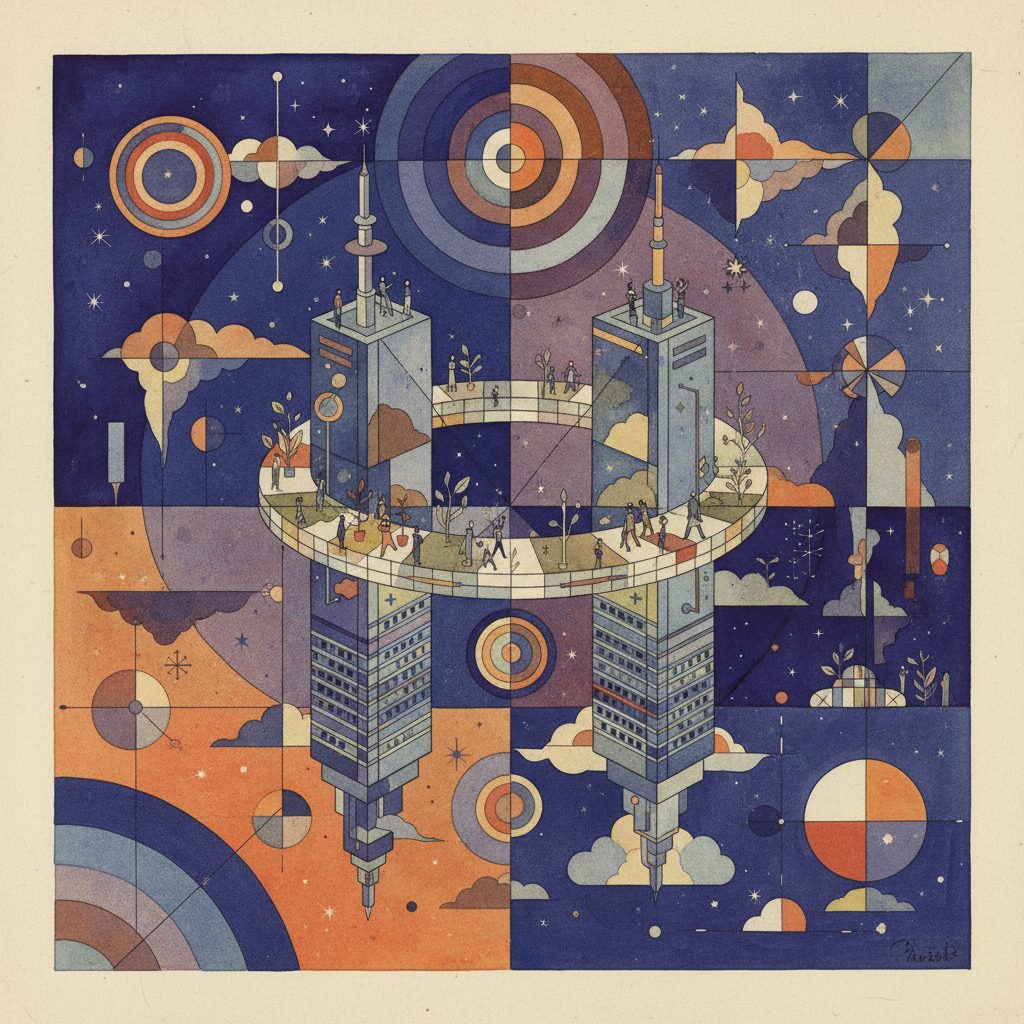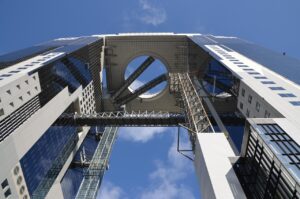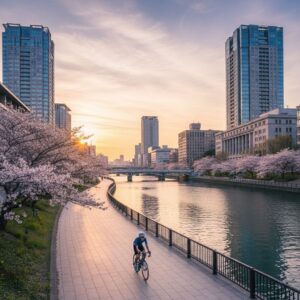In the sprawling urban tapestry of Osaka, a city stitched together with threads of commerce, cuisine, and an irrepressible energy, there stands a structure that doesn’t just scrape the sky—it embraces it. The Umeda Sky Building is not merely another skyscraper in a skyline dense with ambition; it is a statement, a vision of the future conceived in the past, and a gateway to a perspective that can reshape your understanding of this incredible metropolis. From a distance, it appears as two impossibly sleek towers, a monumental gate reaching for the heavens. But it is the space between them, the void that they hold, that contains the building’s true heart: the Floating Garden Observatory. This is not a garden in the traditional sense, with soil and trees. Instead, it is a garden of light, wind, and boundless horizons, a place where the city unfolds beneath you like a living map, and where the human pulse of Osaka can be felt from 173 meters above the ground. To ascend to this circular atrium in the sky is to embark on a small pilgrimage, a journey that lifts you from the kinetic rush of the Umeda district into a realm of serene contemplation. It’s an architectural marvel, a romantic destination, and a profound viewing platform all in one, offering an experience that lingers long after you’ve descended back to the earth. It is, without exaggeration, an essential piece of the Osaka puzzle, a place to find your bearings and lose your breath all at the same time.
After taking in the breathtaking cityscape from the observatory, you might enjoy exploring more of Osaka’s urban beauty by cycling through Nakanoshima Park.
The Ascent: A Bridge to the Heavens

The journey to the Floating Garden Observatory is a carefully designed procession, an architectural story that builds anticipation with each passing moment. It begins on the third floor of the East Tower, where a high-speed elevator swiftly lifts you away from the ground below. The ascent is rapid and silent, a smooth vertical launch that carries you 35 floors in less than a minute. You might feel a slight pop in your ears, a physical sign that you are leaving the familiar behind. But this is only the prelude. The real spectacle starts when the elevator doors open, revealing not the observatory itself, but a gateway to another dimension: the Floating Escalator.
Enclosed within a circular glass tube, these twin escalators create a glowing bridge linking the East Tower to the West Tower, high above the vast gap between them. Stepping onto the moving stairs feels like blasting off into space. Surrounded by glass, you are enveloped by nothing but sky and the city far below. The familiar grid of streets and buildings transforms into an abstract pattern, with cars and people shrinking to tiny specks. There is a tangible sense of suspension, of being held aloft by pure engineering brilliance. As you glide upward at a gentle, unhurried pace, the world outside the glass tube shifts and realigns. This moment is crafted by its architect, Hiroshi Hara, to disconnect you from the ordinary and prepare you for the extraordinary. Hara, a visionary who frequently explored ideas of futuristic cities and interconnectedness, conceived this building not as a static object but as a dynamic space. The escalator is his dramatic touch, a moving pathway that transports you not just physically but emotionally, readying you for the panoramic unveiling that awaits at the top. The experience is a blend of thrill and serenity, a quiet awe that settles in as the hum of the escalator and the vast view become your entire world for a few fleeting minutes. This is more than just a means to an end; it is an essential part of the Floating Garden experience, a rite of passage before you are embraced by the sky.
The Lumi Sky Walk: A Celestial Promenade
Upon reaching the 39th floor, you enter the indoor section of the observatory, a cozy, climate-controlled area with floor-to-ceiling windows offering a stunning preview of the main attraction. Here, you’ll find a cafe to grab a drink and comfortable seating to relax and take in the view. However, the true heart of the Umeda Sky Building awaits one floor above. Climb the final flight of stairs, push open a set of doors, and step outside into the open air. This is the Floating Garden, the Sky Walk—a 360-degree, open-air rooftop corridor that crowns the entire building. The wind greets you immediately, a fresh, clean breeze carrying distant city sounds. Without glass barriers, only a chest-high railing separates you from the breathtaking drop, allowing for an unfiltered, visceral connection with the surroundings.
The experience changes dramatically as the sun sets. When daylight fades and the city begins to sparkle, the floor of the Sky Walk lights up. Embedded with thousands of phosphorescent stones, the pathway glows, creating a celestial river of light beneath your feet. This is the Lumi Sky Walk, a magical feature that makes an evening visit unforgettable. It feels as though you’re wandering through a nebula, with a galaxy of city lights spread before you and a star-dotted path guiding your way. The romantic atmosphere is undeniable, making it a favorite spot for couples, who come to soak in the ambiance and attach “Heart Locks” to a special fence as a symbol of their love.
The view itself is a masterpiece of urban geography. To the north, the silvery expanse of the Yodo River winds toward Osaka Bay, its banks lined with green spaces and crossed by the elegant arches of numerous bridges. You can spot the flight paths of planes approaching Itami Airport, their landing lights blinking in the distance. To the south, the dense cluster of skyscrapers in central Umeda and Nakanoshima rise like a man-made mountain range, showcasing Osaka’s economic strength. On a clear day, your gaze can stretch as far as the Ikoma and Rokko mountain ranges that cradle the Osaka Plain. Yet it is at night when the city truly comes alive. The view transforms into a dazzling, infinite web of gold, white, and red lights—a pulsating organism of energy and life. The arteries of the Hanshin Expressway shine with the steady flow of traffic, and the iconic red Ferris wheel of the HEP Five building adds a playful splash of color to the scene. Standing here, you sense the immense scale and vitality of the Kansai region, a sprawling megalopolis of millions, all contained within your sweeping gaze.
An Icon of Ambition: The Architecture and History

To fully appreciate the Umeda Sky Building, one must know the story behind its creation—a tale of bold vision, pioneering engineering, and the indomitable spirit of late 20th-century Japan. Completed in 1993, the building was conceived during the height of Japan’s “Bubble Economy,” a time of great prosperity and architectural ambition. Originally named the “City of Air,” the project was designed by Hiroshi Hara, who imagined a hyper-connected urban future. His design, featuring two towers joined at the top, was revolutionary. Officially known as a renketsu chōkōsō biru, or “connected super-high-rise building,” it was among the first buildings of its kind worldwide.
The most remarkable aspect of its construction was the technique used to position the Floating Garden Observatory. This massive 10,000-ton circular structure, complete with escalators, was fully assembled on the ground between the two towers. Then, through a remarkable engineering feat called the “Lift-Up” method, the entire assembly was slowly and carefully hoisted more than 150 meters into the air by steel cables and secured in its final place. The process was a high-risk endeavor, showcasing the precision and confidence of Japanese engineering. Watching historical footage of the event, one can feel the tension and ultimate triumph as this donut-shaped piece of sky architecture perfectly connects with the towers.
This history lends the building a deeper significance. It is not merely a place with a view; it stands as a monument to human ingenuity. Its reflective glass facade mirrors the sky, causing the building to change appearance with the weather and time of day—sometimes a steely gray giant, other times a shimmering beacon bathed in the golden light of sunset. While its stark, futuristic look initially drew mixed reactions, it has since been embraced by locals and internationally celebrated, often mentioned alongside landmarks like the Eiffel Tower and the Parthenon for its structural integrity and daring design. It perfectly embodies Osaka’s character: innovative, bold, and forward-looking, yet firmly rooted in exceptional craftsmanship. The building weathered the Great Hanshin Earthquake of 1995 with minimal damage, further proving its robust and forward-thinking design. Today, it stands as a symbol of resilience—a dream born in the bubble era that became a lasting icon for the new millennium.
Below the Clouds: The Nostalgia of Takimi Koji Alley
One of the most delightful and unexpected discoveries at the Umeda Sky Building is found not in the sky, but deep within its foundation. Hidden in the basement is Takimi Koji Alley, a carefully recreated streetscape of Osaka from the early Showa Period (around the 1920s). Descending from the futuristic heights of the observatory into this nostalgic space is like traveling back in time. The contrast is striking and utterly charming.
The atmosphere changes instantly. The sleek modernism of the upper levels gives way to narrow cobblestone streets, vintage wooden shopfronts, and the warm glow of paper lanterns. The air is filled with the enticing aromas of classic Osakan cuisine—the savory scent of grilling okonomiyaki, the sweet and tangy fragrance of takoyaki sauce, and the satisfying sizzle of kushikatsu skewers fresh from the fryer. This is a celebration of kuidaore, the Osakan philosophy of eating until you drop, with the alley lined by small, authentic eateries serving the city’s most beloved dishes.
But Takimi Koji is more than a food court. It’s an immersive historical experience. You’ll spot old-fashioned posters peeling from the walls, a vintage red postal box, a tiny Inari shrine with its red torii gates, and even a classic three-wheeled delivery truck parked in a corner. The attention to detail is exceptional, evoking a deep sense of nostalgia, even for those who never lived through that era. It’s a place that feels alive—a cozy, intimate counterpoint to the expansive, impersonal views from above. Many visitors make a point of combining their observatory visit with a meal here. Watching the sunset from the Floating Garden, then heading down to Takimi Koji for a hearty, traditional dinner is the perfect way to experience two extremes of Osaka’s identity: its soaring, futuristic ambition and its warm, grounded, food-loving spirit. It serves as a reminder that, despite its modernity, Osaka is a city with a rich and cherished history—a past that continues to nourish its present. The alley acts as a cultural anchor, grounding the ethereal experience of the observatory with the tangible, flavorful reality of everyday life.
Navigating Your Visit: Practical Advice and Local Tips

Although the Umeda Sky Building is a prominent landmark, finding its entrance can be a slight challenge for first-time visitors, turning the approach into part of the adventure. The building sits within the Shin-Umeda City complex, just a short walk from both JR Osaka Station and the various Umeda stations serving other lines. The easiest path is through an underground pedestrian tunnel starting near the north side of JR Osaka Station, close to the Yodobashi Camera building. This long, straight underground passage can feel a bit disorienting upon exit. Simply continue walking toward the twin towers rising ahead; they are unmistakable. The observatory entrance is located at the base of the East Tower (the one on your right as you approach).
Timing is crucial to making the most of your visit. The absolute best time to go is in the late afternoon, about an hour before sunset. This timing lets you enjoy the city under three different atmospheres: the warm glow of the setting sun, the gentle twilight of the “magic hour,” and the dazzling city lights as night falls. The transition is stunning and offers the richest photo opportunities. Keep in mind this is also the busiest time, so expect crowds, particularly on weekends and holidays. For a quieter experience, a clear weekday morning visit can be just as rewarding, providing crisp, far-reaching views with fewer people around.
Tickets are available at the ticket counter on the 39th floor, but checking for online bookings ahead of time can help save time. If you’re interested in visiting multiple attractions in the city, consider the Osaka Amazing Pass, which often includes free entry to the Umeda Sky Building as well as many other sites, plus unlimited subway rides, offering excellent value. Once you step onto the open-air Sky Walk, keep in mind that exposure to the elements can make it notably windier and cooler up there than at ground level, even on warm days. Bringing an extra layer, such as a light jacket or sweater, is advisable, especially for evening visits. Don’t rush your time here. Allow at least an hour to an hour and a half to fully take in the views from every angle, enjoy the Lumi Sky Walk, and perhaps unwind with a coffee at Cafe SKY 40. The experience is about more than just seeing the view—it’s about letting it truly resonate with you.
The Heartbeat of a City From Above
Standing on the Floating Garden Observatory evokes a unique sensation—a profound perspective that is both humbling and thrilling. High above the city’s relentless activity, the street noise softens into a distant, gentle murmur. You become a detached observer, witnessing the intricate flow of millions of lives unfolding below. The trains gliding quietly into Osaka Station’s vast complex, the boats leaving delicate trails on the Yodo River, and the endless streams of headlights on the expressways—all merge into a single, living organism. From this perspective, the city seems to breathe.
The atmosphere on the deck is one of shared awe. You hear murmurs in a dozen languages, the soft clicks of camera shutters, and long stretches of quiet contemplation as visitors stand mesmerized by the scale before them. The wind is a constant companion, a tangible link to the vast sky surrounding you. It clears your mind and sharpens your senses. You’re not just viewing a scene through a window; you are part of it, immersed in the skyscape itself. This immersive quality distinguishes the Umeda Sky Building from other observatories, offering a moment of quiet reflection amid the grandeur of one of Japan’s most vibrant urban centers. It’s a place to realize your own smallness in the face of this sprawling human creation while also feeling a strange sense of connection. You can trace the route you took to get here, spot landmarks you intend to visit, and comprehend the city’s layout in a way no map could convey. It gives context, transforming an abstract mix of neighborhoods and train lines into a tangible, understandable whole.
A Lasting Impression

Visiting the Umeda Sky Building’s Floating Garden Observatory is like engaging in a conversation with Osaka itself. It offers more than just sightseeing; it’s a journey through architectural ambition, a passage from a nostalgic past to a shining future, and an opportunity to experience a moment of tranquil beauty high above the city’s hustle. You arrive as a visitor, looking up at its striking structure, and leave with the city imprinted on your memory, having witnessed its soul revealed from a cloud-high vantage point. This place reminds us that, sometimes, truly understanding a city means rising above it. The view from the top is more than a photo; it’s a feeling, a perspective, an unforgettable chapter in your story of Osaka, ready to be written. And as you descend back into the vibrant, welcoming chaos of the streets, you carry a part of that sky with you.








